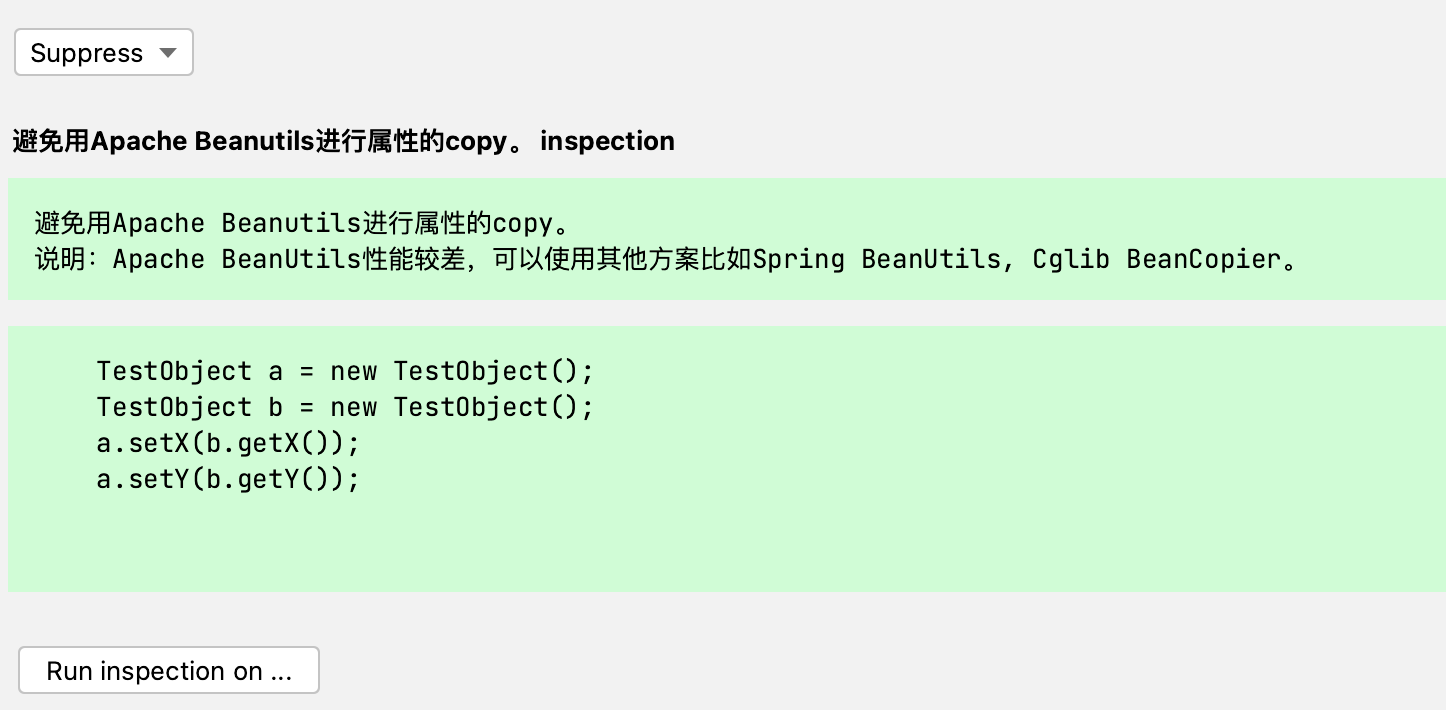# 缘起
有一次开发过程中,刚好看到小伙伴在调用 set 方法,将数据库中查询出来的 Po 对象的属性拷贝到 Vo 对象中,类似这样:

可以看出,Po 和 Vo 两个类的字段绝大部分是一样的,我们一个个地调用 set 方法只是做了一些重复的冗长的操作。这种操作非常容易出错,因为对象的属性太多,有可能会漏掉一两个,而且肉眼很难察觉。
类似这样的操作,我们很容易想到可以通过反射来解决。其实,如此普遍通用的功能,一个BeanUtils工具类就可以搞定了。
于是我建议这位小伙伴了解一下 BeanUtils,后来他使用了 Apache BeanUtils.copyProperties 进行属性拷贝,这为程序挖了一个坑!
# 阿里代码规约
当我们开启阿里代码扫描插件时,如果你使用了 Apache BeanUtils.copyProperties 进行属性拷贝,它会给你一个非常严重的警告。因为,Apache BeanUtils性能较差,可以使用 Spring BeanUtils 或者 Cglib BeanCopier 来代替。

看到这样的警告,有点让人有点不爽。大名鼎鼎的 Apache 提供的包,居然会存在性能问题,以致于阿里给出了严重的警告。
那么,这个性能问题究竟是有多严重呢?毕竟,在我们的应用场景中,如果只是很微小的性能损耗,但是能带来非常大的便利性,还是可以接受的。
带着这个问题。我们来做一个实验,验证一下。
如果对具体的测试方式没有兴趣,可以跳过直接看结果哦~
# 测试方法接口和实现定义
首先,为了测试方便,让我们来定义一个接口,并提供各种实现:
public interface PropertiesCopier {
void copyProperties(Object source, Object target) throws Exception;
}
public class CglibBeanCopierPropertiesCopier implements PropertiesCopier {
@Override
public void copyProperties(Object source, Object target) throws Exception {
BeanCopier copier = BeanCopier.create(source.getClass(), target.getClass(), false);
copier.copy(source, target, null);
}
}
// 全局静态 BeanCopier,避免每次都生成新的对象
public class StaticCglibBeanCopierPropertiesCopier implements PropertiesCopier {
private static BeanCopier copier = BeanCopier.create(Account.class, Account.class, false);
@Override
public void copyProperties(Object source, Object target) throws Exception {
copier.copy(source, target, null);
}
}
public class SpringBeanUtilsPropertiesCopier implements PropertiesCopier {
@Override
public void copyProperties(Object source, Object target) throws Exception {
org.springframework.beans.BeanUtils.copyProperties(source, target);
}
}
public class CommonsBeanUtilsPropertiesCopier implements PropertiesCopier {
@Override
public void copyProperties(Object source, Object target) throws Exception {
org.apache.commons.beanutils.BeanUtils.copyProperties(target, source);
}
}
public class CommonsPropertyUtilsPropertiesCopier implements PropertiesCopier {
@Override
public void copyProperties(Object source, Object target) throws Exception {
org.apache.commons.beanutils.PropertyUtils.copyProperties(target, source);
}
}
# 单元测试
然后写一个参数化的单元测试:
@RunWith(Parameterized.class)
public class PropertiesCopierTest {
@Parameterized.Parameter(0)
public PropertiesCopier propertiesCopier;
// 测试次数
private static List<Integer> testTimes = Arrays.asList(100, 1000, 10_000, 100_000, 1_000_000);
// 测试结果以 markdown 表格的形式输出
private static StringBuilder resultBuilder = new StringBuilder("|实现|100|1,000|10,000|100,000|1,000,000|").append("|----|----|----|----|----|----|");
@Parameterized.Parameters
public static Collection<Object[]> data() {
Collection<Object[]> params = new ArrayList<>();
params.add(new Object[]{new StaticCglibBeanCopierPropertiesCopier()});
params.add(new Object[]{new CglibBeanCopierPropertiesCopier()});
params.add(new Object[]{new SpringBeanUtilsPropertiesCopier()});
params.add(new Object[]{new CommonsPropertyUtilsPropertiesCopier()});
params.add(new Object[]{new CommonsBeanUtilsPropertiesCopier()});
return params;
}
@Before
public void setUp() throws Exception {
String name = propertiesCopier.getClass().getSimpleName().replace("PropertiesCopier", "");
resultBuilder.append("|").append(name).append("|");
}
@Test
public void copyProperties() throws Exception {
Account source = new Account(1, "test1", 30D);
Account target = new Account();
// 预热一次
propertiesCopier.copyProperties(source, target);
for (Integer time : testTimes) {
long start = System.nanoTime();
for (int i = 0; i < time; i++) {
propertiesCopier.copyProperties(source, target);
}
resultBuilder.append((System.nanoTime() - start) / 1_000_000D).append("|");
}
resultBuilder.append("");
}
@AfterClass
public static void tearDown() throws Exception {
System.out.println("测试结果:");
System.out.println(resultBuilder);
}
}# 测试结果
| 实现 | 100 | 1,000 | 10,000 | 100,000 | 1,000,000 |
| StaticCglibBeanCopier | 0.053561 | 0.680016 | 1.196787 | 2.924973 | 10.769302 |
| CglibBeanCopier | 4.099259 | 12.252336 | 33.50937 | 48.940261 | 104.005539 |
| SpringBeanUtils | 3.802291 | 9.268228 | 26.635362 | 118.699586 | 162.996875 |
| CommonsPropertyUtils | 6.797116 | 20.59255 | 49.380707 | 219.271803 | 1857.382452 |
| CommonsBeanUtils | 23.566713 | 106.971358 | 473.95897 | 2619.767277 | 26199.132175 |
结果表明,Cglib 的 BeanCopier 的拷贝速度是最快的,即使是百万次的拷贝也只需要 10 毫秒! 相比而言,最差的是 Commons 包的 BeanUtils.copyProperties 方法,100 次拷贝测试与表现最好的 Cglib 相差400 倍之多。百万次拷贝更是出现了2600 倍的性能差异!
结果真是让人大跌眼镜。
但是它们为什么会有这么大的差异呢?
# 原因分析
查看源码,我们会发现 CommonsBeanUtils 主要有以下几个耗时的地方:
输出了大量的日志调试信息
重复的对象类型检查
类型转换
public void copyProperties(final Object dest, final Object orig)
throws IllegalAccessException, InvocationTargetException {
// 类型检查
if (orig instanceof DynaBean) {
...
} else if (orig instanceof Map) {
...
} else {
final PropertyDescriptor[] origDescriptors = ...
for (PropertyDescriptor origDescriptor : origDescriptors) {
...
// 这里每个属性都调一次 copyProperty
copyProperty(dest, name, value);
}
}
}
public void copyProperty(final Object bean, String name, Object value)
throws IllegalAccessException, InvocationTargetException {
...
// 这里又进行一次类型检查
if (target instanceof DynaBean) {
...
}
...
// 需要将属性转换为目标类型
value = convertForCopy(value, type);
...
}
// 而这个 convert 方法在日志级别为 debug 的时候有很多的字符串拼接
public <T> T convert(final Class<T> type, Object value) {
if (log().isDebugEnabled()) {
log().debug("Converting" + (value == null ? "" : " '" + toString(sourceType) + "'") + " value '" + value + "' to type '" + toString(targetType) + "'");
}
...
if (targetType.equals(String.class)) {
return targetType.cast(convertToString(value));
} else if (targetType.equals(sourceType)) {
if (log().isDebugEnabled()) {
log().debug("No conversion required, value is already a " + toString(targetType));
}
return targetType.cast(value);
} else {
// 这个 convertToType 方法里也需要做类型检查
final Object result = convertToType(targetType, value);
if (log().isDebugEnabled()) {
log().debug("Converted to " + toString(targetType) + " value '" + result + "'");
}
return targetType.cast(result);
}
}Java Bean Copy框架性能对比:https://yq.aliyun.com/articles/392185
# One more thing
除了性能问题之外,在使用 CommonsBeanUtils 时还有其他的坑需要特别小心!
1、包装类默认值
在进行属性拷贝时,低版本CommonsBeanUtils 为了解决Date为空的问题会导致为目标对象的原始类型的包装类属性赋予初始值,如 Integer 属性默认赋值为 0,尽管你的来源对象该字段的值为 null。
这个在我们的包装类属性为 null 值时有特殊含义的场景,非常容易踩坑!例如搜索条件对象,一般 null 值表示该字段不做限制,而 0 表示该字段的值必须为0。
2、改用其他工具时
当我们看到阿里的提示,或者你看了这篇文章之后,知道了 CommonsBeanUtils 的性能问题,想要改用 Spring 的 BeanUtils 时,要特别小心:
org.apache.commons.beanutils.BeanUtils.copyProperties(Object target, Object source); org.springframework.beans.BeanUtils.copyProperties(Object source, Object target);
从方法签名上可以看出,这两个工具类的名称相同,方法名也相同,甚至连参数个数、类型、名称都相同。但是参数的位置是相反的。因此,如果你想更改的时候,千万要记得,将 target 和 source 两个参数也调换过来!
